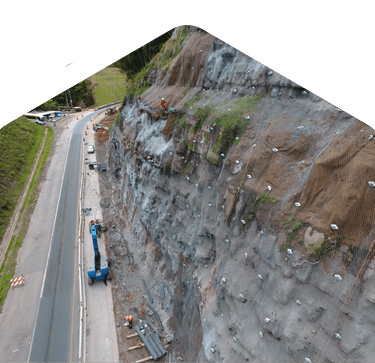

Deep horizontal drains are responsible for keeping the water table lowered, preventing an unwanted rise in the water level of the massif. These elements must be designed according to the specific hydrogeological and rainfall studies of each location, and the assembly of the elements must allow water to enter the tube and be directed out of the massif. They are made up of perforated pipes, wrapped in geotextiles and/or screens, or geotubes (permeable tubes).
They consist of rigid facing, generally made of reinforced concrete (either pumped or shotcrete), equipped with anchors embedded in the ground to counteract active (or at-rest) earth pressures. These anchors, made with special steel bars or low-relaxation steel strands, are prestressed, pushing the rigid facing against the ground, ensuring slope stability and preventing undesirable mass movements.
This technique is used for stabilizing natural slopes and embankments. Its primary stabilizing mechanism is the restriction of massif deformations. Unlike anchors, soil nails do not have a free length and are considered passive elements because they are only activated when there is a tendency for mass movement. Generally, they are not pre-tensioned. The facing can be made of high-strength wire mesh or shotcrete. In some cases, nailed soil may not have any facing on the slope surface.
Responsible for directing rainwater to watercourses. This proper direction prevents excessive infiltration of rainwater, which can harm the stability of the massif. Additionally, the correct sizing of the drainage network prevents erosion on slopes, which can develop into surface landslides, gullies, and more.
These are flexible barriers designed to contain or slow down rock blocks. This solution is applied when stabilizing the rock blocks comprehensively becomes economically unfeasible. Dynamic barriers are sized by energy and must be capable of absorbing the potential energy that is converted into kinetic energy during the rockfall movement.
This involves installing devices in predetermined locations to measure various quantities relevant to the stability of a given massif, such as pore pressures, deformations, water levels, etc. The most commonly used instruments are Piezometers, Water Level Indicators, Inclinometers, Surface Markers, Topographic Prisms, Crack Meters, and Settlement Pins. Other instruments can also be installed to verify specific parameters of the location.
Tunnel supports are responsible for containing potential rock block detachments (in the case of rock tunnels). The main type of mass movement addressed by these solutions is rockburst, which is a sudden "explosion" of solid rock, resulting in the detachment of rock mass with significant energy release.
Slope cleaning is important because it allows for the identification of potential issues that are not visible through a superficial layer of vegetation, such as cracks and erosions. Additionally, for monitoring some slopes using prisms, for example, slope cleaning is necessary to ensure that the topographic equipment can accurately target the instrument in question. This cleaning can be performed manually, mechanically, or remotely, depending on the complexity of the site access and the stability condition of the slope and/or dam.
These are fundamental parts of the infrastructure for special structures located in hard-to-access areas, such as very high and steep slopes or large and deep valleys, where it is not possible to execute the foundation using conventional market equipment.